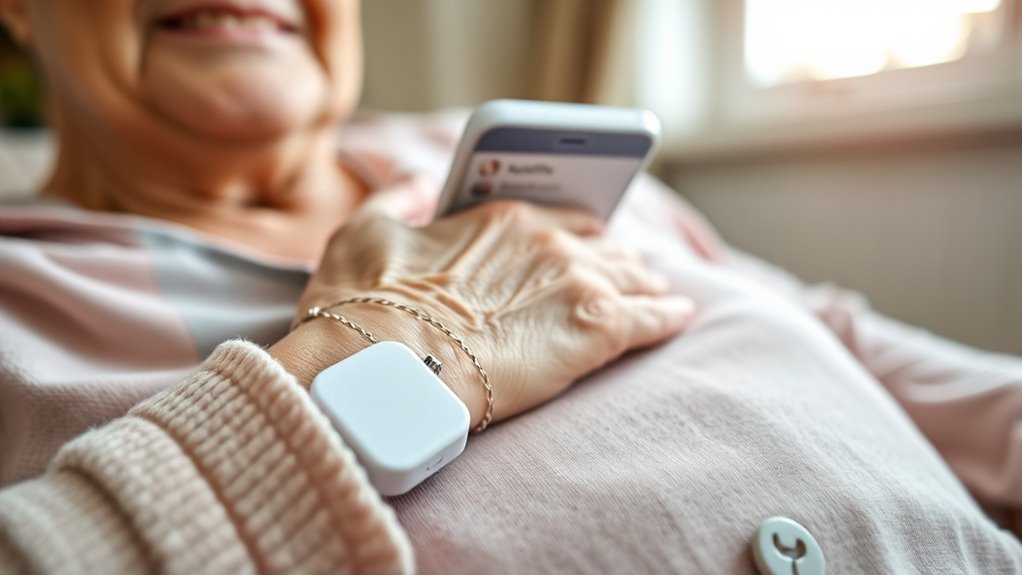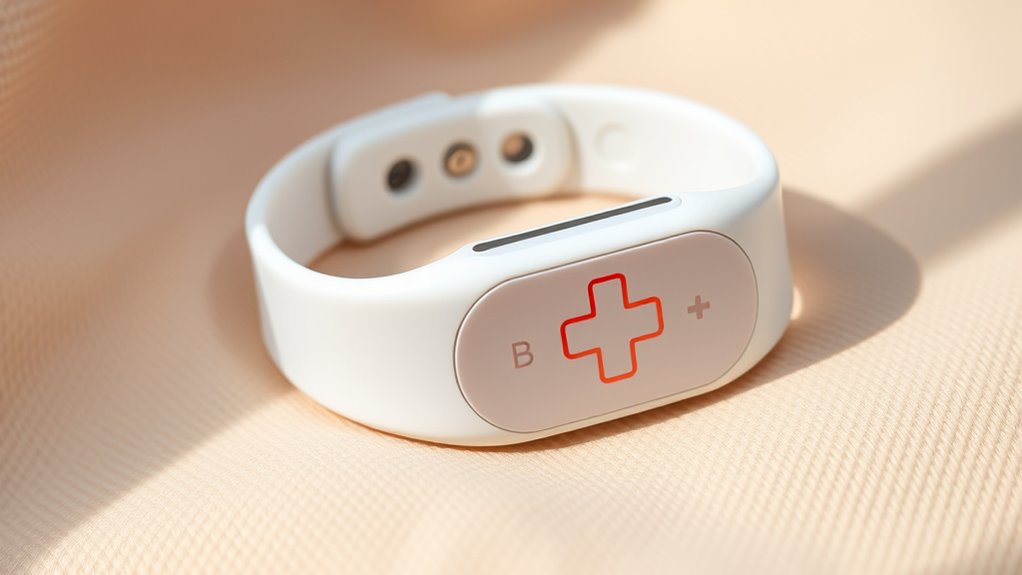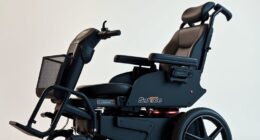Using a medical alert system allows you to get immediate help in emergencies by simply pressing a button or speaking a command. These devices use GPS for exact location tracking, two-way voice communication, and automatic fall detection to *guarantee* help arrives quickly. They connect you to trained responders who assess your situation and dispatch emergency services if needed. If you want to learn more about how these systems can keep you safe and independent, keep exploring the options available.
Key Takeaways
- Activate the system manually via a button press or voice command during an emergency.
- Ensure GPS and communication features are functioning for accurate location and direct contact.
- Regularly test the system to confirm responsiveness and proper connection to the response center.
- Share your system details with family or caregivers for monitoring and support.
- Follow safety protocols and keep the device charged and within reach at all times.

Have you ever wondered how seniors or individuals with health conditions can get immediate help in an emergency? Medical alert systems are designed to do just that, providing a quick and reliable way to summon assistance when it’s needed most. These systems utilize advanced emergency response features combined with cutting-edge technology integration to guarantee help arrives promptly, no matter the situation. When you activate a medical alert system, you’re connecting to a dedicated response center staffed by trained professionals who can assess your situation and dispatch emergency services if necessary. This seamless process reduces response times and increases the chances of receiving timely care, which can be lifesaving.
Technology integration plays a fundamental role in making these systems efficient and user-friendly. Modern medical alert devices often come equipped with features like GPS tracking, two-way voice communication, and automatic fall detection. GPS technology allows responders to locate you precisely, even if you’re away from home or unable to communicate your location. Two-way voice communication means you can speak directly with the response center without needing to dial a phone, which is especially useful if you’re unable to reach a phone or are feeling unwell. Automatic fall detection sensors can identify if you’ve fallen and notify the response team immediately, eliminating the need for you to press a button during a crisis. These technological advancements enhance the overall emergency response, making it faster, more accurate, and more dependable. Additionally, advances in security features like password protection and encryption ensure your personal information remains safe, further increasing trust in these systems.
Furthermore, integration with smartphones and other devices ensures that users can operate their alert systems easily and stay connected at all times. Some systems sync with mobile apps, allowing family members or caregivers to monitor your status and receive alerts if you need help. This integration gives you peace of mind, knowing that help can be summoned instantly, even if you’re unable to do so yourself. The security and reliability offered by these systems are essential, especially for seniors who want to maintain independence without sacrificing safety.
In essence, the combination of emergency response capabilities and sophisticated technology integration makes medical alert systems a critical tool in managing health emergencies. They empower individuals to take control of their safety and provide reassurance to loved ones. With continuous advancements in technology, these systems are becoming even more intuitive and effective, ensuring that help is always just a button-press or voice command away. So, whether you’re at home or out in the community, a medical alert system offers a dependable safety net, helping you stay safe and connected no matter what.
Frequently Asked Questions
How Long Does the Battery Last on Average?
On average, the battery lifespan of medical alert systems ranges from 24 to 72 hours, depending on the device and usage. Good power management can extend this time, so you should regularly charge the device and follow manufacturer recommendations. Keep in mind that some systems have rechargeable batteries, which require routine maintenance to guarantee reliable performance. Proper power management helps you maintain peace of mind and ensures your system stays operational when needed most.
Can the System Be Used Internationally?
Yes, your medical alert system can be used internationally if it has international compatibility and roaming capabilities. You’ll want to verify with your provider to make certain the device works in the countries you visit. Many systems now support global networks, so you can stay connected in emergencies no matter where you are. Always confirm roaming options and coverage before traveling to avoid surprises and ensure your safety abroad.
Are There Hidden Fees or Ongoing Costs?
Did you know nearly 60% of users overlook hidden charges when choosing alert systems? You should know that most systems have transparent subscription fees, but some may include hidden charges or ongoing costs. Always read the fine print to avoid surprises. Be cautious, as certain plans might have extra fees for international use or service upgrades. Staying informed helps you select a system that fits your budget and needs without unexpected expenses.
What Is the Installation Process Like?
The installation process is straightforward. You’ll start by reviewing the setup requirements, such as power sources and device placement. Next, follow the installation steps provided, which often involve connecting the base unit to your phone line or Wi-Fi and testing the system. Most systems offer simple, step-by-step instructions, and some providers even offer professional installation if you prefer. Overall, it’s designed to be quick and hassle-free.
How Quickly Does Help Arrive After an Emergency?
You might be surprised how fast help arrives, thanks to the emergency response team’s swift action and system reliability. Usually, assistance comes within minutes after you press the button, ensuring peace of mind when it matters most. Ironically, the very system designed to protect you often seems to work too quickly—yet that’s exactly what you want in an emergency. Rest assured, your safety is a top priority with these reliable systems.
Conclusion
Think of a medical alert system as your safety net when life gets unpredictable. Like the firefighter who’s always ready to spring into action, these devices guarantee help arrives instantly in emergencies. For example, Sarah, a senior, pressed her button during a fall, and help was there before she even hit the floor. Investing in a medical alert system gives you peace of mind, knowing support is just a button away—your safety net in life’s unexpected moments.









